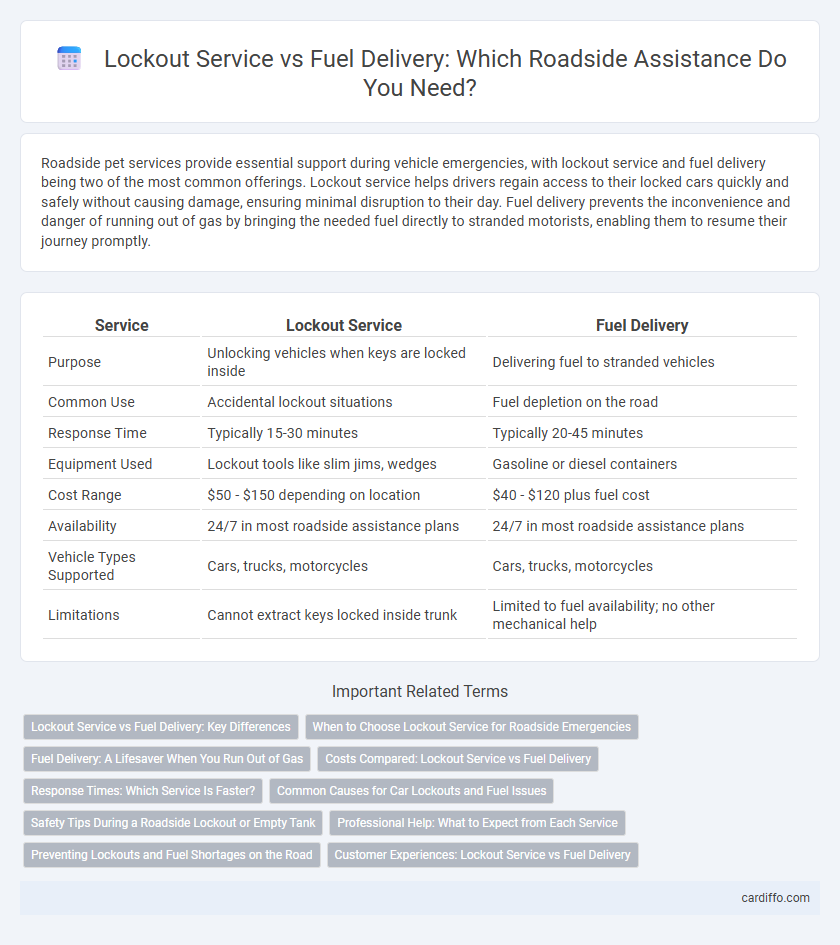Roadside pet services provide essential support during vehicle emergencies, with lockout service and fuel delivery being two of the most common offerings. Lockout service helps drivers regain access to their locked cars quickly and safely without causing damage, ensuring minimal disruption to their day. Fuel delivery prevents the inconvenience and danger of running out of gas by bringing the needed fuel directly to stranded motorists, enabling them to resume their journey promptly.
Table of Comparison
| Service | Lockout Service | Fuel Delivery |
|---|---|---|
| Purpose | Unlocking vehicles when keys are locked inside | Delivering fuel to stranded vehicles |
| Common Use | Accidental lockout situations | Fuel depletion on the road |
| Response Time | Typically 15-30 minutes | Typically 20-45 minutes |
| Equipment Used | Lockout tools like slim jims, wedges | Gasoline or diesel containers |
| Cost Range | $50 - $150 depending on location | $40 - $120 plus fuel cost |
| Availability | 24/7 in most roadside assistance plans | 24/7 in most roadside assistance plans |
| Vehicle Types Supported | Cars, trucks, motorcycles | Cars, trucks, motorcycles |
| Limitations | Cannot extract keys locked inside trunk | Limited to fuel availability; no other mechanical help |
Lockout Service vs Fuel Delivery: Key Differences
Lockout service provides immediate access to a locked vehicle by using specialized tools to unlock doors without causing damage, designed for scenarios when keys are lost or locked inside. Fuel delivery service assists drivers who run out of fuel by delivering the necessary gasoline or diesel directly to the vehicle's location, preventing the need to walk to a gas station. While lockout service resolves access issues, fuel delivery focuses on mobility restoration by refueling stranded vehicles.
When to Choose Lockout Service for Roadside Emergencies
Choose a lockout service when you're physically unable to access your vehicle due to keys being lost, locked inside, or broken. Unlike fuel delivery, which is necessary only when your vehicle runs out of gas, lockout assistance is critical for ensuring quick entry to prevent delays or emergencies. Opt for lockout service during roadside incidents that require immediate access to the car's interior, prioritizing safety and convenience.
Fuel Delivery: A Lifesaver When You Run Out of Gas
Fuel delivery is a critical roadside assistance service that swiftly resolves the inconvenience and danger of running out of gas. Unlike lockout service, which addresses vehicle access issues, fuel delivery eliminates the risk of being stranded on busy roads or in remote areas by providing timely gasoline or diesel directly to the vehicle. This service enhances safety and minimizes delays, ensuring drivers can continue their journeys without unnecessary interruption.
Costs Compared: Lockout Service vs Fuel Delivery
Lockout service costs typically range from $50 to $120 depending on time and location, while fuel delivery fees generally fall between $50 and $100 plus the price of fuel. Lockout assistance often incurs a flat rate, whereas fuel delivery pricing fluctuates based on fuel type and market rates. Choosing between services hinges on urgency and cost-effectiveness relative to specific roadside needs.
Response Times: Which Service Is Faster?
Lockout service typically offers faster response times compared to fuel delivery due to the urgency and simplicity of unlocking a vehicle versus sourcing and transporting fuel. While lockout providers often reach customers within 15-30 minutes, fuel delivery may take up to 45 minutes or more depending on fuel availability and location. Efficient dispatch systems and proximity to service vehicles are crucial factors influencing the overall speed of roadside assistance.
Common Causes for Car Lockouts and Fuel Issues
Car lockouts commonly occur due to lost or broken keys, faulty electronic key fobs, or accidental locking of keys inside the vehicle. Fuel delivery problems often arise from running out of gas, contaminated fuel, or a malfunctioning fuel pump. Understanding these frequent causes helps roadside assistance providers offer timely lockout service and fuel delivery to restore vehicle access and operation efficiently.
Safety Tips During a Roadside Lockout or Empty Tank
During a roadside lockout or empty tank situation, prioritize safety by staying visible and avoiding traffic lanes. Use hazard lights and reflective triangles to alert other drivers, and remain inside your vehicle if conditions are unsafe. Always keep a charged phone for emergency calls and avoid risky attempts to unlock doors or siphon fuel.
Professional Help: What to Expect from Each Service
Lockout service provides expert assistance by safely unlocking your vehicle without causing damage, using specialized tools operated by trained technicians. Fuel delivery offers a quick refuel solution when you run out of gas, with professionals bringing the appropriate fuel type directly to your location. Both services ensure timely, reliable support designed to minimize disruption during roadside emergencies.
Preventing Lockouts and Fuel Shortages on the Road
Regularly checking your fuel levels and keeping a spare key accessible can significantly reduce the chances of roadside lockouts and fuel shortages. Utilizing GPS-enabled fuel stations and lockout assistance apps ensures timely access to these services, minimizing delays during emergencies. Proactive vehicle maintenance and monitoring help prevent unexpected lockouts and running out of fuel, enhancing overall road safety and trip reliability.
Customer Experiences: Lockout Service vs Fuel Delivery
Lockout service typically provides rapid access solutions, minimizing customer stress by quickly restoring vehicle entry, whereas fuel delivery addresses unexpected fuel shortages, preventing delays and improving convenience. Customers often report higher satisfaction with lockout services due to the immediate resolution of immobilizing situations. Fuel delivery is praised for its reliability in emergencies, offering peace of mind during long trips or remote locations.
Lockout service vs fuel delivery Infographic

 cardiffo.com
cardiffo.com